Common menu bar links
Institutional links
Diseases & Conditions
Health & Safety
Research & Statistics
Agency Information
Search Box
E-mail this page
Brief Report on Sexually Transmitted Infections in Canada: 2006
Gonorrhea (Neisseria gonorrhoeae)
Gonorrhea, an infection caused by Neisseria gonorrhoeae, has been reportable nationally since 1924 and remains the second most commonly reported STI in Canada. Consequences of untreated gonorrhea infection are of concern for both sexes but can be especially severe for women. Young women can develop pelvic inflammatory disease (PID), which can lead to chronic abdominal pain, infertility and ectopic pregnancy. Males with an untreated infection are at risk of epididymitis and, rarely, infertility. Though uncommon, gonorrhea can spread to the blood stream and joints3 . Like other non-ulcerative STIs, gonorrhea can increase the concentration of cells in genital secretions that can serve as targets for HIV thereby increasing the risk of acquisition and/or transmission of HIV2 .
Since 1997, the reported rate of gonorrhea infections has increased, more in men than women.
- In 2006, 11,334 cases of gonorrhea infections were reported nationally, corresponding to a rate of 34.7 per 100,000 (Figure 5). The overall reported rate of gonorrhea infection in 2006 increased by 21.5% from 2005 (28.5 per 100,000) and by 132.8% when compared to 1997 reported rates (14.9 per 100,000).
- Between 1997 and 2006, reported gonorrhea rates among males increased by 140.4% (from 17.8 to 42.3 per 100,000) compared to a 126.7% increase (from 12.0 to 27.2 per 100,000) in reported rates among females during the same time period (Figure 5).
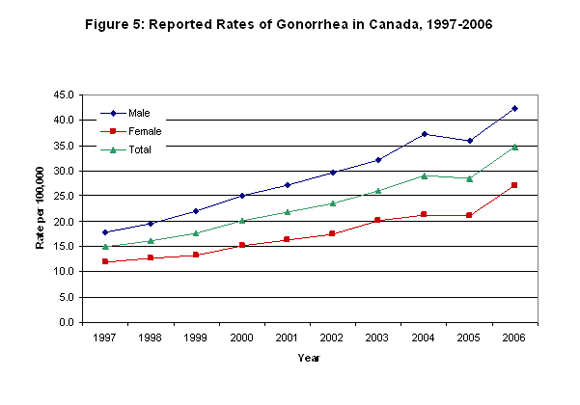
The age-specific rates of gonococcal infections are highest among the younger population.
- In 2006, people under 30 years of age continue to account for the majority (65%) of reported cases. This is in contrast with chlamydia and infectious syphilis, in which the same age group accounts for 83% and 20% of reported cases, respectively.
- Among women, the 15 to 19-year age group accounted for the highest age-specific rate of reported gonorrhea infections (143.8 per 100,000) (Figure 6).
- Among men, the highest age-specific rate was among the 20 to 24-year olds (141.1 per 100,000) (Figure 6).
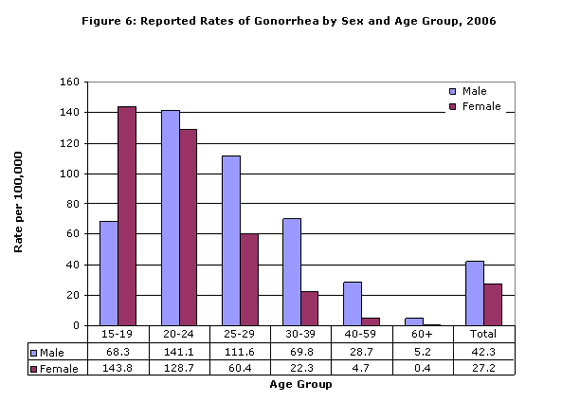
Since 1997, the largest increase in the reported rate of gonorrhea infection is in older age groups.
- Between 1997 and 2006, reported rates of gonorrhea were increasing across age groups. The most dramatic increase was in males over 60 years of age at 386.0% (from 1.1 to 5.2 per 100,000). This is followed closely by women aged 40-59 with an increase of 335.8% (1.1 to 4.7 per 100,000).
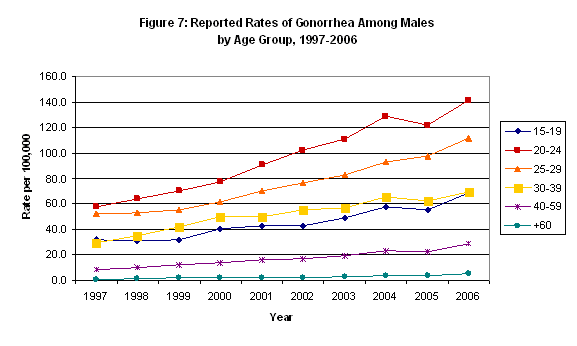
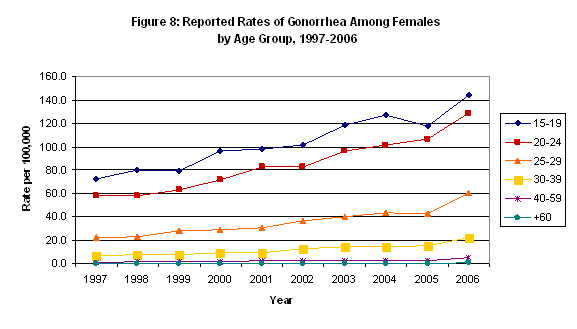
Though the majority of gonorrhea cases occur in the most populous provinces of the country, rates are highest in the North.
- In 2006, the highest reported rates of gonorrhea were in the Northwest Territories, Nunavut and Manitoba (Table 2).
- The highest number of gonorrhea cases was reported in Ontario, followed by Alberta and Manitoba (Table 2).
- Between 1997 and 2006, the greatest increase in reported rates was in Alberta, with an increase of 345.5% (Table 2).
- In 2006, the national male-to-female ratio was 1.5:1, reflecting that more males are reported with gonococcal infections than females. However, this average masks variation across the country. The male-to-female ratio was highest in Quebec (2.5:1), while in Yukon, more females are reported than males (1:1.8).
Table 2. Reported Cases and Rates of Gonorrhea by Province/Territory, 1997 and 2006
| Jurisdiction | Number of cases | Rate per 100,000 | Rate change1 1997-2006 (%) | ||
| 1997 | 2006 | 1997 | 2006 | ||
| NL | 3 | 8 | 0.5 | 1.6 | 189.7 |
| PE | 1 | 0 | 0.7 | 0.0 | -100.0 |
| NS | 108 | 101 | 11.6 | 10.8 | -6.5 |
| NB | 15 | 32 | 2.0 | 4.3 | 114.8 |
| QC | 545 | 1271 | 7.5 | 16.6 | 122.6 |
| ON | 1931 | 3871 | 17.2 | 30.5 | 77.5 |
| MB | 518 | 1576 | 45.6 | 133.7 | 193.4 |
| SK | 342 | 954 | 33.5 | 96.6 | 188.7 |
| AB | 406 | 2149 | 14.3 | 63.8 | 345.5 |
| BC | 458 | 1078 | 11.6 | 25.0 | 115.7 |
| YT | 0 | 11 | 0.0 | 35.2 | * |
| NT2 | 150 | 181 | 221.5 | 426.9 | N/A |
| NU2 | N/A | 102 | N/A | 335.5 | N/A |
| Canada | 4477 | 11334 | 14.9 | 34.7 | 132.5 |
1 Rate change calculated using unrounded values.
2 Nunavut did not officially become a territory until 1999; prior to 1999, data for Nunavut was combined with Northwest Territories. Rate change for NT was not calculated since 1997 rates are not comparable with 2006 rates due to the creation of Nunavut.
* The rate change cannot be quantified.
Antimicrobial Resistance
Uncomplicated gonorrhea can be treated with single dose oral or injectable antibiotics. The challenge arises when resistant strains are treated with antibiotics to which the bacteria have decreased susceptibility. When this occurs, there is increased likelihood of transmission due to treatment failure and the development of adverse sequelae unless the resistant organism is identified and treated appropriately. Gonococcal resistance to penicillin, erythromycin and tetracycline is long established. None of these antibiotics are recommended treatments1 .
- Canadian gonococcal resistance surveillance is a collaborative effort between the National Microbiology Laboratory (NML) at PHAC and provincial and territorial laboratories.
- Submission to the NML of gonococcal isolates that have decreased susceptibility to at least one antibiotic is voluntary and not standardized across the country.
- Antibiotics tested for gonococcal resistance at the NML include penicillin, tetracycline, spectinomycin, erythromycin, azithromycin, ciprofloxacin, cefixime and ceftriaxone.
- In 2006, 28.8% of cultured strains demonstrated resistance to ciprofloxacin, up from 2.4% in 2003 (Figure 9).
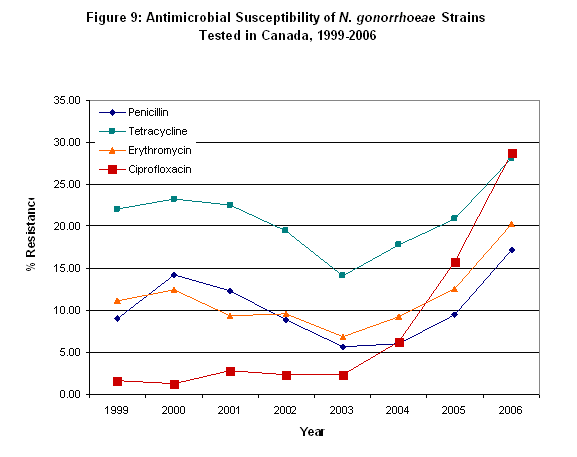
* Percentages are calculated using the number of specimens tested as the denominator.
There are no resistant strains for spectinomycin, cefixime, and ceftriaxone.
